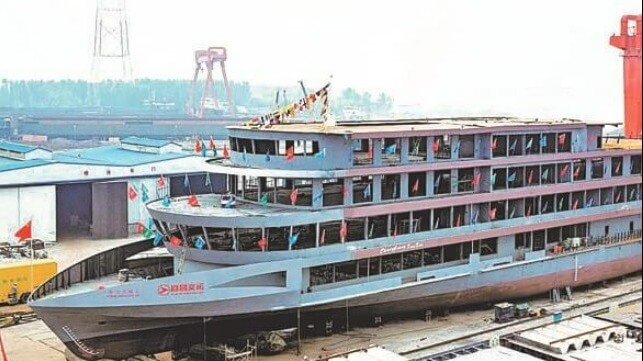China to Ramp Up Electric Ship Production

[By: CCS]
China Classification Society (CCS) says China will ramp up the building of fully electric battery powered ships to operate on the country’s extensive inland waterways network following the successful maiden voyage of the CHANG JIANG SAN XIA 1, a 100m length cruise ship with the largest battery power in the world.
The CHANG JIANG SAN XIA 1 was successfully delivered at the YICHANG XIN HUI SHIPBUILDING CO LTD on the Yangtze River in the Hubei province. The ship has capacity for 1300 passengers and will sail in the reservoir areas of the Gezhouba Dam and Three Gorges Dam in Yangtze River.
CCS says its Yichang office oversaw the plan approval and building survey while its Wuhan Rules & Research Institute provided technical support for the green technology and intelligence elements of the vessel.
Mr Luo Xiaofeng, Director of Wuhan Rules & Research Institute, said the CHANG JIANG SAN XIA 1 can slash an estimated 530 tonnes of diesel fuel and 1660 tonnes of GHG and hazardous gas emissions each year with 7.5 MWh marine power lithium battery system that is equivalent to the power of 100 electric cars, which compared to a similar diesel powered vessel. The ship will be charged by hydroelectric energy with a range of no less than 100 kilometres. It is also one of the first all-electric ships to adopt a system of high-voltage charging and low-voltage power supplement.
The vessel will play a key role in promoting the green development of the Yangtze River shipping industry, which has received increasing attention in recent years. In 2020, four ministries, including ministry of transport and ministry of Eclology and Environment, issued a joint plan to curb ship and port pollution, urging comprehensive improvements in pollution prevention and acceleration of the green development of the shipping industry along the Yangtze River Economic Belt.
“CCS is very proud to have worked on this groundbreaking project with the talented team at Yichang Xinhui Shipyard,” said Xu Junjie the GM to CCS Yichang. “The project demonstrates the implementation of advance Lithium Battery Power Ship Rules and the building of electric inland waterway vessels in China. We expect that the innovations made on this vessel about the size and power of the battery can promote the development of environmentally friendly electric vessels. We have learned a lot particularly about de-risking the build process and the overall safety of electric powered ships.”
Mr Xu said the ship design of CHANG JIANG SAN XIA 1 has achieved several Chinese “firsts”.
“This vessel adopts the marine power LFP-type battery system that meets the world’s top standard,” he said. “The ship is Demonstration Projects of Ministry of Industry and Information Technology in Hi-tech Research Ships and is Pilot Projects of Ministry of Transport for Building China with Strong Transportation Network. CCS fully supports the Government’s drive for greener inland waterways and hope what we are learning can be shared with the wider maritime industry as the sector strives towards meeting the IMO GHG emissions targets.”
Mr Luo said the CHANG JIANG SAN XIA 1 obtained the notations of “Green Ship” as well as meeting high standards of vibration and noise reduction.
“CCS Wuhan Rules & Research Institute is closely involved in the project and our battery power technicians are working closely with the ship designer and builder to solve technical problems and control battery power risks. For example, the unconventional requirements for assembling, welding, installation and commissioning. We further examined the problems in battery installation and system tests, providing training, to improve the capability of the shipyard.”
Mr Lou said the successful delivery of the ship is a breakthrough in environmental protection and ship intelligent control and marks the successful application of the CCS Rules for Inland Green Ships, which will lead the development of electric vessels in China.
The products and services herein described in this press release are not endorsed by The Maritime Executive.
